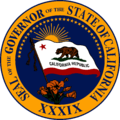Felipe de Neve
| Felipe de Neve | |
|---|---|
 Statue of Felipe de Neve in the Los Angeles Plaza. The inscription reads: "Felipe de Neve (1728-84). Governor of California 1775-82. In 1781, on orders from King Carlos III of Spain, Felipe de Neve selected a site near the River Porciuncula and laid out the town of El Pueblo de La Reina de Los Angeles, one of two pueblos he founded in Alta California." | |
|
In office March 1770 – March 4, 1775 | |
| Preceded by | Fernando Rivera y Moncada |
| Succeeded by | Pedro Fages |
| Personal details | |
| Born |
1724 Bailén, Province of Jaén (Spain)[1] |
| Died |
1784 Coahuila, Mexico |
| Nationality | Spanish |
| Occupation | Explorer and Governor of California |
Felipe de Neve (1724–1784) was fourth governor of Alta California, from 1775 to 1782.[1][2] Neve is considered a founder of Los Angeles, California and helped to settle towns of Santa Barbara and San José whose surrounding communities became California cities.[3][4][5]
Career highlights
First capital
Felipe de Neve was appointed governor of the Californias in 1775.[5] For two years he was based at Loreto, Baja California, then moved to Monterey, California.[3][6]
New settlements
- Las Californias
It was during Neve's administration that Lieutenant José Joaquín Moraga is credited with building the Presidio of San Francisco, after the site was selected by Juan Bautista de Anza in 1776. Moraga is also known as the founder of El Pueblo de San José de Guadalupe, the present day city of San Jose, California. On 29 November 1777, Moraga founded San José on orders from Antonio María de Bucareli y Ursúa, the Spanish Viceroy of New Spain. It was the first Spanish colonial pueblo in the northern region of Las Californias Province, which became its own Alta California Province in 1804. The city served as a farming community to support the Presidio of San Francisco and the Presidio of Monterey.
In 1781, later in Neve's tenure, he founded the Pueblo de Los Ángeles. Neve had applied to Viceroy Bucareli for permission to establish a settlement (pueblo) near the Los Angeles River (Río de Porciúncula), where Father Juan Crespí had met local Tongva Indians. With the viceroy's approval, Neve was granted authority from The Crown, Charles III of Spain, to found and establish the second pueblo in upper Las Californias, El Pueblo de Nuestra Señora la Reina de los Ángeles del Río de Porciúncula (The Pueblo of Our Lady Queen of the Angels of the River of Porciúncula), the present day city of Los Angeles, California.
During Neve's tenure as governor, he quarreled constantly with the missionaries' leader, padre Junípero Serra, over the secularization of the Missions and the redistribution of land to the Mission Indian neophytes and soldiers. During his tenure four missions were founded: Mission San Francisco de Asís also called Mission Dolores (June 29, 1776), Mission San Juan Capistrano (November 1, 1776), Mission Santa Clara de Asís (January 12, 1777) and Mission San Buenaventura (March 31, 1782).
Comandante general
Neve's success as provincial governor won him promotion in 1783 to succeed Teodoro de Croix as Comandante General of the Provincias Internas, a position that had authority over all the northern provinces (including Las Californias). He held that position until his death in 1784.
See also
References
- 1 2 "NEVE, FELIPE DE (1724–1784)". tshaonline.org. Retrieved 2010-04-14.
- ↑ "Landmarks of Hispanic Los Angeles". USC Library archives. Retrieved 2010-04-14.
- 1 2 "Spanish Governors". missiontour.org. Retrieved 2010-04-14.
- ↑ "CHAPTER III". www.usgennet.org. Retrieved 2010-04-14.
- 1 2 "The True Origins of Spanish Colonial Officials and Missionaries". www.sandiegohistory.org. Retrieved 2010-04-14.
- ↑ "Phelipe de Neve First Governor of the Californias, 1777–1782". www.sbthp.org. Retrieved 2010-04-14.
Sources
- Clyde Arbuckle (1986). Clyde Arbuckle's History of San Jose. Smith McKay Printing. ISBN 978-9996625220.
- The Town of Our Lady Reina of the Angels on the Porciúncula river. (English)
Bibliography
Beilharz, Edwin A. Felipe de Neve: First Governor of California. San Francisco: California Historical Society, 1971.
External links
| Wikimedia Commons has media related to Felipe de Neve. |
